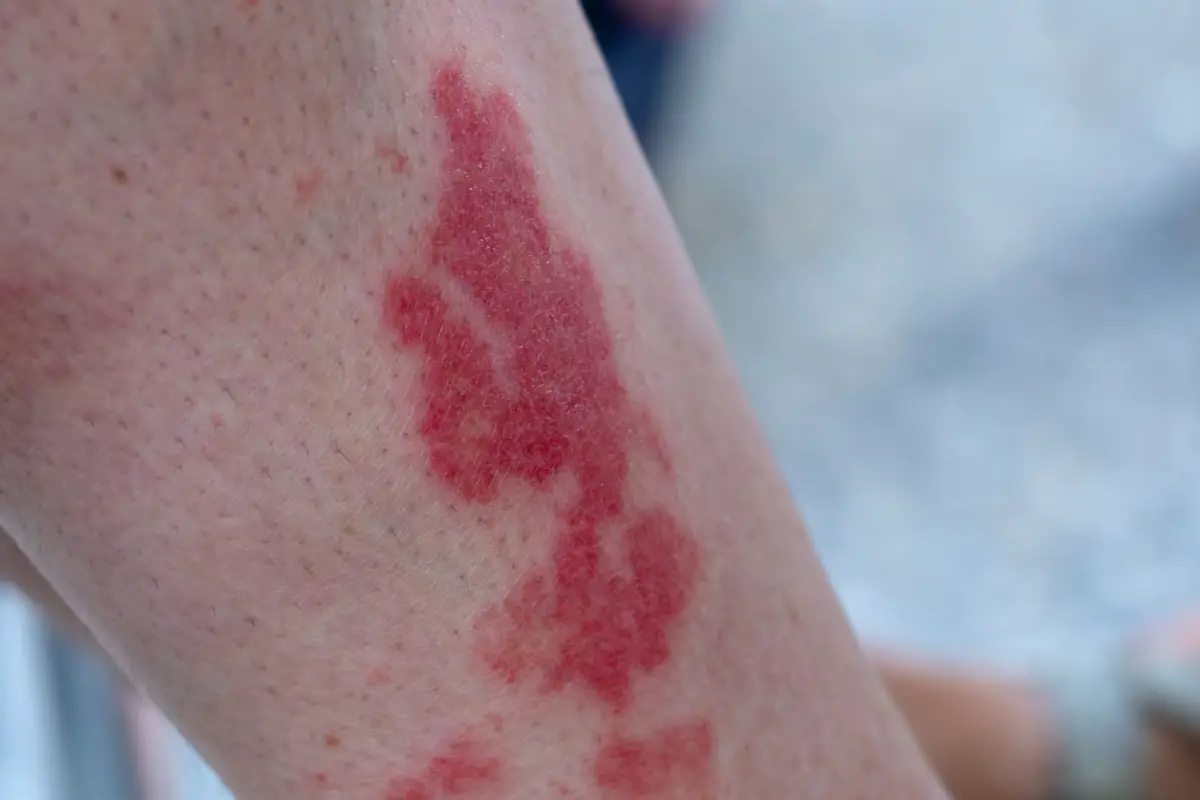If you’re like me, you love spending time outdoors hiking and biking in the warm weather. But did you know there is a risk of developing a nasty rash from all that activity?
This article will discuss what causes hiker’s rash, how to prevent it, and what treatments are available if you develop it.
Hiker rash is caused by consistent rubbing, and its technical name is exercise-induced vasculitis (EIV). The leading causes are exposure to hot weather, sunlight exposure, and prolonged hiking periods, so a prolonged exercise like thru-hiking itself lends itself to the occurrence.
While called a “rash,” this is an inflammation issue with the blood vessels.
Let’s dig into what to look for and how you can look to manage it, as it’s not cheap to take days off the trail to heal in many circumstances.
Recognizing the Signs of Hiker’s Rash
For those who haven’t heard of EIV(1), it looks like discoloration on your legs and ankles. This can and is frequently accompanied by swelling and can range from ankles to thighs, frequently including red patches, dots, and even raised welts.
In addition, this can be accompanied by itching, burning, tingling, or stinging in the area. Some people have no physical feelings, though they have hikers’ rash.
An interesting note is that it is most common in exposed skin, not the skin under clothing items, and less exposed to the sun. For a thru-hiker, though, this can last a long time as it will resolve on its own, but hikers rash can last up to 10 days after leaving the area or conditions that bring it on.
An interesting note: If you get hikers’ rash once, it is seen to have a much more common re-occurrence for you. So, if it happens to you on your shakedown hikes, work to develop your plan for the actual thru-hike to manage it.
Treating Hiker’s Rash on the Trail
Now, on to where the shoe hits the trail. How do you take care of hikers’ rash on the trail when you. have limited access to multiple days out of the sun, air conditioning, and consistent running water?
Interestingly enough, many of them are things a longer hiker should generally be doing as part of their day hiking as they involve breaks, protective clothing, massaging and rolling out muscles, and similar on-trail body maintenance.
Use a Cool Washcloth
If you bring some form of a camp towel, I use a ShamWow, as it’s incredible for tent condensation cleanup. Take it out, soak it in cold water from a stream, and lay it over the affected area to help drop the inflammation response.
Elevate Your Feet
This is a good thing for any hiker to do since you will have some blood pool lower in the body with constant walking for 10+ hours each day.
Putting your legs up allows the body to use gravity to flow blood.
Soak Your Feet and Legs
When you find a decent stream with some depth, stop, take your shoes off, and get them into the flowing cool bath using the water.
This will help to drop the overall inflammatory response from the area and assist with general swelling. It feels terrific in humid weather!
Protect Your Skin From Sun Exposure
One of the simplest things for a thru-hiker to manage while on the trail is to cover as much of the impacted areas with clothing.
Adding leggings or similar legwear with socks would help you without any significant issues on the trail.
Massage Your Legs
Your muscles will have massive blood flow and oxygen needs from pumping all day. Give them some TLC once in camp using a cork massage ball to massage the large muscle groups like quads, hamstrings, and glutes.
Doing this will help improve blood flow and assist with recovery, which can also help to drop the chance of EIV.
Wear Compression Clothing
Another thing many on a thru-hike will do by default is wear compression clothing to help with recovery and managing swelling, which also helps with blood flow.
One thing people have said worked wonders was using compression socks for their legs to help them have fewer issues over prolonged activity. I don’t use them nor have much experience using them, but if you do, this could be a good gear fix.
Wear Moisture-Wicking Clothing
Another gear most hikers will use is moisture-wicking when in humid areas, which helps keep the skin dry and can assist in preventing EIV as well.
Preventing Hiker’s Rash on Long Hikes
There are ways to help prevent any issues from becoming a problem by taking proper preventative steps.
Many, myself included, try to push miles and skip breaks at times, choosing to eat on the move and limiting “downtime.”
Instead, you must learn some measure of consistent breaks and ensure you are properly hydrated with enough water and electrolytes to keep the body at peak performance.
Take More Frequent Breaks
In 100% transparency, I am horrible at taking breaks. I go hours without stopping and relaxing as I set goals before I start the day, but breaks are a fantastic prevention method for many issues.
Whereas my wife and daughter, when they come, are looking for a break every hour or so, their approach drives me nuts, but it is much better to prevent issues like this from occurring.
When you take these breaks, you want to get your shoes off, if time permits, and work to get your legs up so that blood circulation can occur with more ease and stop pooling in your legs.
Use Streams to Cool Off
On long-distance hikes, you will frequently encounter streams and high-volume flowing rivers where you can give your body much love by allowing the water to cool you off.
This will help drop your core temperature and help with any inflammation that has already begun, allowing you to stop it before it becomes a problem or issue that causes you to need a break from the trail.
Staying Hydrated
This is a solution to numerous issues that can happen on the trail, and in general, proper hydration is something we all should strive for daily.
When you are sweating a lot, as you will be when hiking long distances in hot weather, you need to ensure that you are replenishing what is being lost with water and electrolytes.
I bring LMNT as my electrolyte supplement on purpose as they come in friendly, easy little packages that can be torn open and dropped into a water bottle without also being hyper-sweet. To me, this is perfect when on the trail.
Final Thoughts on Hikers’ Rash and Management
There are many ways to manage what is known as hikers’ rash, and the best way will depend on your circumstances. However, remember to take care before and after noticing any issues to help prevent them from worsening.
As always, if you have any questions, drop them below in the comments or email me, and I’ll get back to you as soon as possible. Until next time, happy hiking!


Leave a Comment